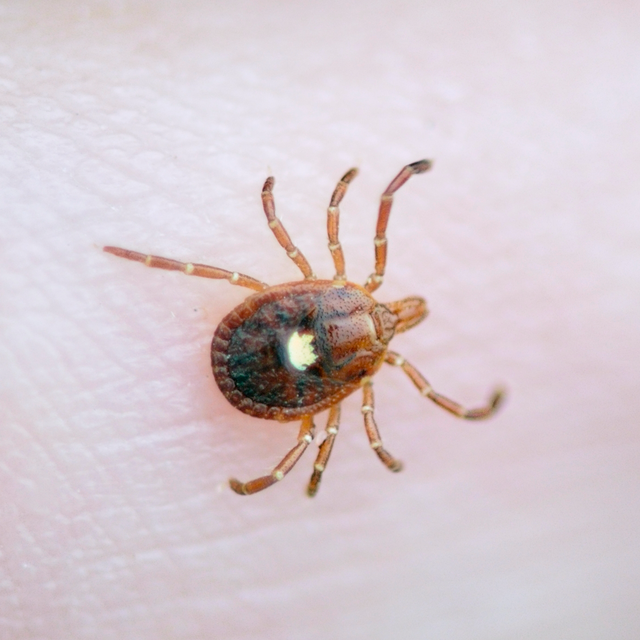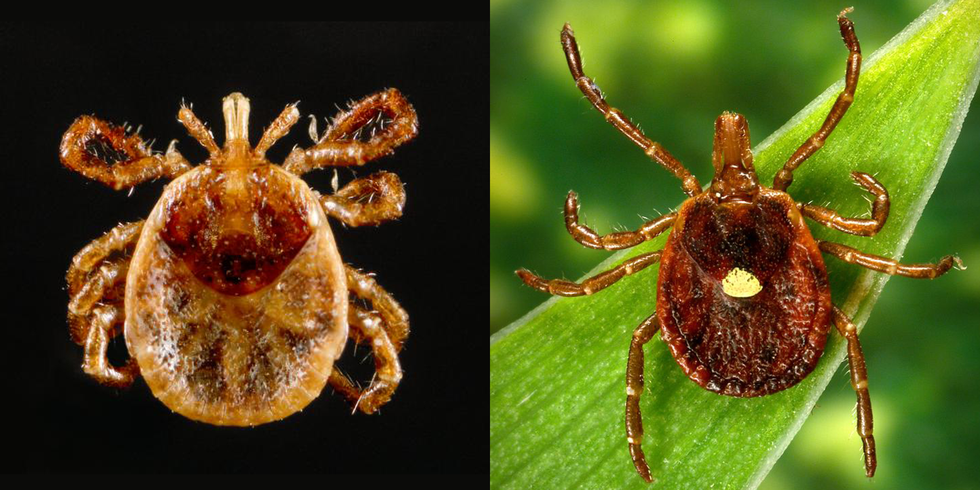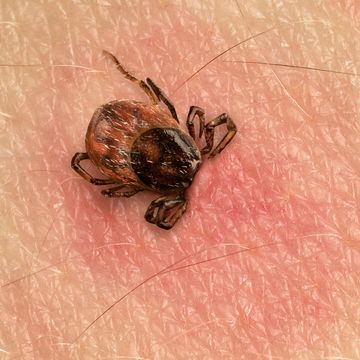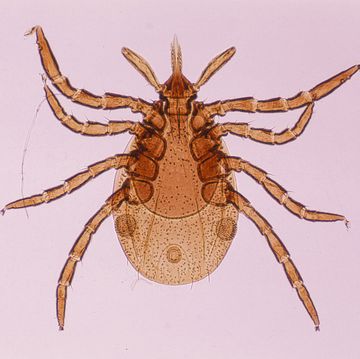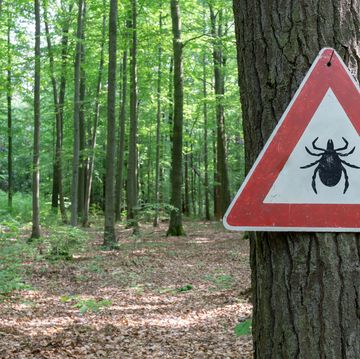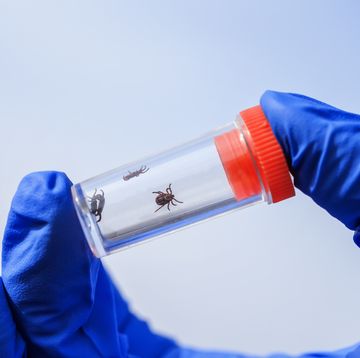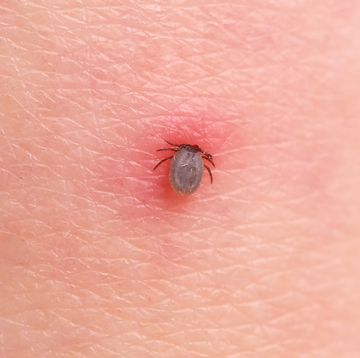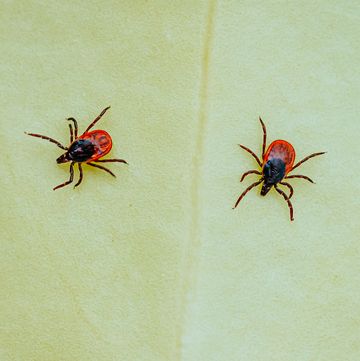By now, nearly everyone knows the dangers of blacklegged ticks. They’re the tiny tick species largely responsible for spreading Lyme disease throughout the country. But there’s a lesser-known type of tick that’s also creeping through parts of the United States, growing in size and geography: the lone star tick.
Often characterized by a single white dot on its back, the lone star tick is becoming a growing issue in eastern states, and is one of the driving forces behind the explosion of tick-borne diseases in the past 20 years, according to the Centers for Disease Control and Prevention (CDC).
“The lone star tick is common in the southeastern part of the U.S.,” says Mike Merchant, Ph.D., a professor and urban entomologist at Texas A&M University’s AgriLife Extension Service. “Its range has actually been expanding farther north as temperatures get warmer.”
According to a 2019 paper published in the New England Journal of Medicine, lone star ticks “may be recolonizing areas where they thrived historically, before rampant deforestation and substantial local reduction of key hosts.” The authors link this resurgence, in part, to climate change.
That means we’re probably going to be getting much more familiar with lone star ticks—and possibly even the diseases they carry—in the years to come. Here, everything you should know about the blood-sucking bug.
What do lone star ticks look like?
Female lone star ticks are easy to identify, because they have a signature white dot on the center of their shields. Male lone stars lack that spot, and have subtle lines or horseshoe-shaped streaks at the edges of their backs instead. Both are a deep reddish, brown color. According to the CDC, though, a nymph (pictured left below) and adult females (pictured right below) are the ones most likely to bite humans.
Where can you find lone star ticks in the U.S.?
“The range for the lone star tick goes from Texas, up to Iowa, across to Maine, and all the way down to Florida,” Merchant says. “It’s basically the lower third of the whole U.S.” The CDC notes that they’re more common in the South, but that their reach is expanding to the North and Midwest.
Lone star tick diseases
Merchant notes that not all ticks carry diseases and lone star ticks are not known to carry Lyme disease, but they can pass on various other illnesses:
1. Alpha-gal syndrome
While this isn’t technically a disease, the lone star tick is most famous for its ability to spur a red meat allergy. Alpha-gal is a form of sugar found in red meat, and lone star ticks may carry this sugar in their saliva (after biting another animal, like a deer). If it then bites you, the sugar can travel through your blood and cause your immune system to overreact by pumping out histamine as a response.
This can result in mild to severe allergic reactions after a person eats red meat, leading to symptoms like hives, swelling, wheezing, nausea, and vomiting. It can even cause anaphylaxis, a life-threatening reaction that can lead to trouble breathing or low blood pressure. “We have seen patients whose first reaction lands them in the ER,” Scott P. Commins, M.D., Ph.D., an associate professor in medicine in the division of rheumatology, allergy, and immunology at the UNC School of Medicine recently told Prevention.
2. Ehrlichiosis
This flu-like disease is primarily spread to humans by lone star and blacklegged ticks, and a majority of infections are caused by the E. chaffeensis bacteria, per the CDC. Symptoms can develop within one to two weeks of a bite, and include a fever, chills, muscle aches, nausea, vomiting, diarrhea, confusion, and, in children, sometimes a splotchy, dotted rash that forms within five days of developing a fever.
People most commonly report ehrlichiosis in the southeastern and south-central regions of the U.S., but it’s worth noting that Missouri, Arkansas, New York, and Virginia experienced more than half of all reported cases (1,799) in 2018, the CDC notes.
3. Tularemia
This disease is caused by a highly infectious bacteria that is typically transmitted via lone star ticks and dog ticks. Tularemia can actually present in many forms, but two of the most common associated with tick bites are ulceroglandular and glandular, the CDC says. With ulceroglandular tularemia, you may develop a skin ulcer—a raw, red, painful sore—at the site of the bite, leading to swelling in glands like your armpit or groin. Glandular tularemia is similar but does not produce an ulcer. In both cases, a high fever is common.
Tularemia has been reported all over the U.S., but pops up more frequently in south-central regions, the Pacific Northwest, and parts of Massachusetts. It is considered rare, though, as only 229 cases were reported in 2018.
4. Heartland virus
This is a very rare disease caused by a Phlebovirus, which is transmitted by mosquitoes, sandflies, and lone star ticks. As of 2017, just over 30 cases have been reported in the Midwest and South, the CDC reports. Symptoms have often presented within two weeks of a bite, and can include fever, fatigue, decreased appetite, headache, muscle pain, nausea, and diarrhea. Few patients die from Heartland virus, but many end up needing treatment at a hospital.
5. Bourbon virus
Another very rare disease believed to be caused by lone star ticks, Bourbon virus has only impacted a “limited number” of people in the Midwest and South, some of who have died, the CDC says. Researchers are still learning more about the symptoms, but the virus may cause a fever, tiredness, rash, headache, body aches, nausea, and vomiting.
6. Southern tick-associated rash illness (STARI)
This rare rash, often confused with the bullseye-shaped rash associated with Lyme disease, is caused by a bite from a lone star tick. (See images confirmed by the CDC here.) However, experts aren’t sure what, exactly, causes it. A STARI rash often forms a week after a bite, can expand to a 3-inch diameter or more, and may be accompanied by fatigue, headache, fever, and muscle pains. Similar to Lyme, STARI is often treated with oral antibiotics.
What should I do if I’ve been bitten by a lone star tick?
If you find a lone star tick (or any tick, for that matter) attached to your skin, you should remove it as soon as possible, Merchant says. He recommends using a pair of tweezers, which will help you pull the tick out with steady, even pressure. (Check out our full guide on how to remove a tick properly.)
Once you’ve washed the bite site with some soap and water, “the best thing you can do is to stick it in a Ziploc bag, put it in your freezer, and forget about it,” Merchant says. “If you get any kind of rash or any unusual, flu-like symptoms within a couple of weeks of being bitten, pull the tick out of your freezer and bring it to your doctor.”
If you do happen to have a tick-borne illness, the frozen tick will help your doctor figure out a proper diagnosis and treatment plan.
And to prevent those pesky bites in the first place? Always apply a tick repellent before heading out to grassy, brushy, and woody locations, wear long long sleeves and pants if the weather permits it, and check out these tips on how to get rid of ticks.
Support from readers like you helps us do our best work. Go here to subscribe to Prevention and get 12 FREE gifts. And sign up for our FREE newsletter here for daily health, nutrition, and fitness advice.

Jake Smith, an editorial fellow at Prevention, recently graduated from Syracuse University with a degree in magazine journalism and just started going to the gym. Let's be honest—he's probably scrolling through Twitter right now.
